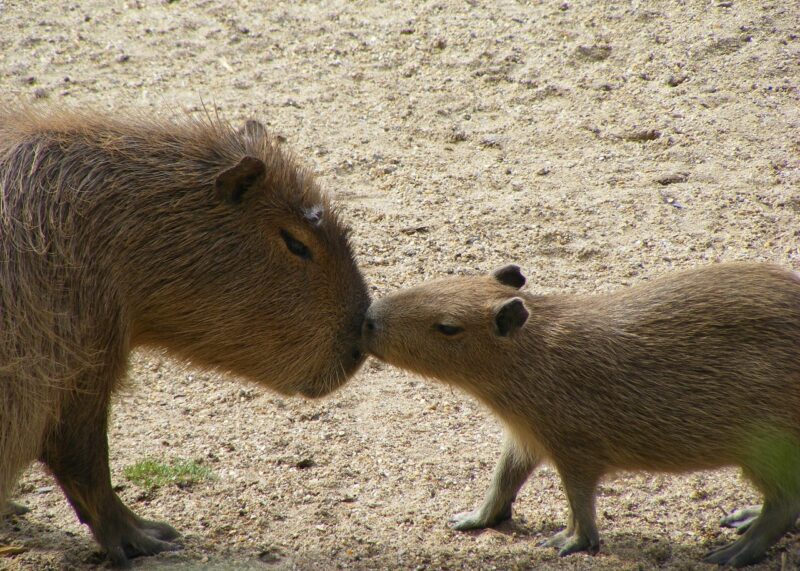Capybaras in South America: How These Social Animals Adapt to Life in the Wild
November 13, 2024

Capybaras, the world’s largest rodents, are fascinating creatures that capture the hearts of many. Known for their friendly demeanor and social nature, these animals inhabit the wetlands and grasslands of South America. With their sturdy bodies and webbed feet, capybaras are superbly adapted to semi-aquatic life. In this article, we will explore how these remarkable animals thrive in the wild, their social behaviors, and the challenges they face in their natural habitats.
1. Introduction to Capybaras
Capybaras (Hydrochoerus hydrochaeris) are native to South America and can be found in countries like Brazil, Venezuela, Colombia, and Argentina. Emerging from the dense thickets of their natural habitats, capybaras are often spotted basking in the sun near bodies of water. These gentle giants weigh between 77 to 150 pounds, and their stout bodies can reach lengths of up to 4 feet.
Capybaras are herbivores, primarily feeding on grasses and aquatic plants. Their large, flat teeth are perfectly designed for gnawing, allowing them to serve their dietary needs efficiently.
2. Social Structure and Behavior
Capybaras are highly social animals, typically living in groups that range from 10 to 20 individuals, though larger groups can be found in areas with abundant resources. These social structures play a critical role in their survival.
The benefits of living in a group include:
- Increased Protection: By living in a group, capybaras can better defend themselves against predators. Together, they keep a lookout for threats, and their collective vigilance enhances their safety.
- Resource Sharing: In foraging for food, living in groups allows capybaras to cover more ground efficiently, increasing their chances of finding sustenance, which is crucial, especially during dry seasons.
- Reproductive Success: Group living enhances breeding opportunities and cooperative care of the young, ensuring the survival and health of the next generation.
Capybaras exhibit a range of vocalizations, including barks, whistles, and purrs, communicating their feelings and intentions effectively within their groups. These social dynamics play an important role not just in survival but in the animal’s emotional health.
3. Adaptations to the Environment
Being semi-aquatic, capybaras have several physical adaptations that make living both in water and on land easier:
- Webbed Feet: Their webbed feet provide excellent swimming capabilities, enhancing their ability to maneuver in water while providing stability on land.
- Thick Fur: Capybara fur is coarse and helps repel water, keeping them buoyant while swimming. Their fur color, varying from brown to reddish-brown, also provides camouflage against predators in their natural habitat.
- Large Eyes and Nostrils: Positioned on top of their heads, their large eyes and nostrils enable capybaras to see and breathe while mostly submerged, an important advantage when evading potential threats.
These adaptations not only aid in survival but also facilitate the major part of their lifestyle, which happens on or near water. Capybaras are often seen swimming gracefully, diving under the surface for food or escaping from danger.
4. Habitat and Distribution
Capybaras inhabit a range of environments, from savannas to marshlands, primarily favoring areas close to water sources. Rivers, lakes, and wetlands provide ample grazing area while offering a refuge from predators like jaguars and caimans.
While they are found in a variety of habitats, the following are exemplary of their preferred environments:
- Wetlands: Capybaras thrive in tropical and subtropical wetlands, where their diet of aquatic plants and grasses is abundant.
- Grasslands: Open grasslands serve as forage areas but are typically located near water bodies, making them ideal for capybara activities.
- Forested Regions: Areas with dense thickets offer protection from predators while providing a diverse diet of higher plants and shrubs.
These diverse habitats enable capybaras to adapt and survive in a variety of conditions, but this adaptability also means they can be vulnerable to habitat loss due to agricultural development and urbanization.
5. Predators and Challenges
While capybaras have several adaptations for survival, they face threats from various predators, including:
- Jaguars: As formidable carnivores, jaguars often hunt capybaras due to their size and vulnerability when on land.
- Caimans: These reptiles pose a significant threat in water. Capybaras must stay vigilant when swimming near their habitats.
- Humans: Habitat destruction and hunting pose perhaps the most significant risks for capybara populations as land is transformed for agriculture or urban development.
Conservation efforts are paramount in protecting capybara populations from diminishing further. Establishing protected areas and managing land use effectively can help preserve their natural habitats and ensure the survival of these gentle giants.
6. Conclusion: A Future for Capybaras
Capybaras are a remarkable example of how social behavior and physical adaptations enable animals to thrive in their natural environments. Their ability to form tight-knit groups and navigate complex ecosystems showcases their intelligence and resilience. However, with increasing pressures from habitat loss and environmental changes, it is crucial to ensure the well-being of these creatures for future generations. Protecting their habitats and raising awareness of their ecological significance are vital steps in safeguarding capybaras and the ecosystems they represent.
As we continue to study and admire these unique rodents, let us remain committed to preserving their habitats and the rich biodiversity of South America that supports them.
If you found this article helpful, consider supporting conservation efforts that protect wildlife and their habitats. For more information, visit local wildlife organizations or participate in conservation activities.







